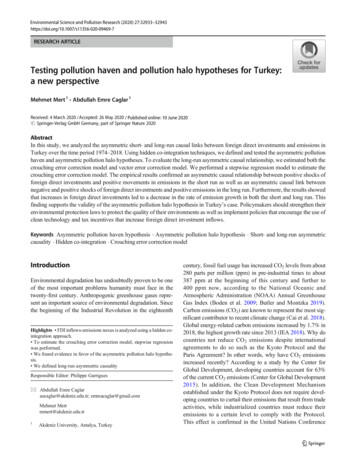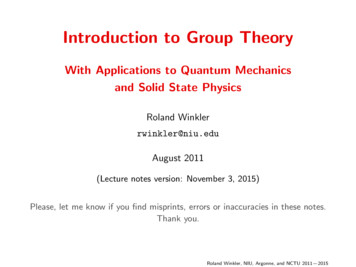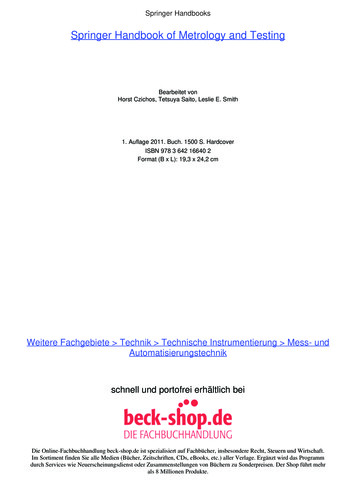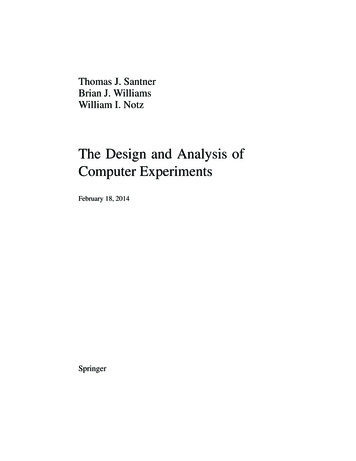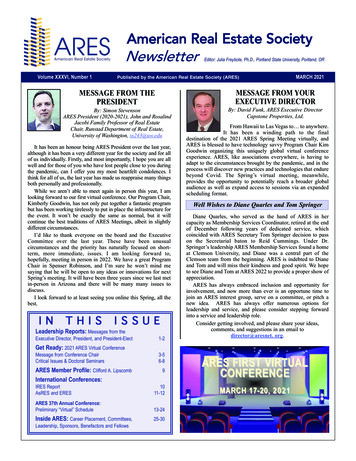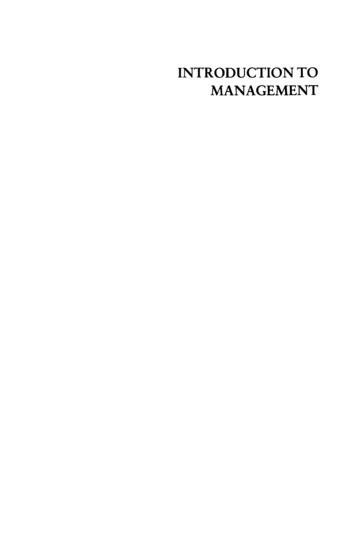
Transcription
INTRODUCTION TOMANAGEMENT
INTRODUCTION TOIMANAGEMENTRichard PettingerMMACMILLAN
Richard Pettinger 1994All rights reserved. No reproduction, copy or transmission ofthis publication may be made without written permission.No paragraph of this publication may be reproduced, copied ortransmitted save with written permission or in accordance withthe provisions of the Copyright, Designs and Patents Act 1988,or under the terms of any licence permitting limited copyingissued by the Copyright Licensing Agency, 90 Tottenham CourtRoad, London W1P 9HE.Any person who does any unauthorised act in relation to thispublication may be liable to criminal prosecution and civilclaims for damages.First published 1994 byTHE MACMILLAN PRESS LTDHoundmills, Basingstoke, Hampshire RG21 2XSand LondonCompanies and representativesthroughout the worldISBN 978-0-333-59769-9ISBN 978-1-349-23258-1 (eBook)DOI 10.1007/978-1-349-23258-1A catalogue record for this book is availablefrom the British Library.Copy-edited and typeset by Povey-EdmondsonOkehampton and Rochdale, England
I ContentsList of figures and summary boxesPrefacexx1vAcknowledgementsxvii1 Introduction1Background to management1The professionalisation of management2Management as a field of study4Management research and literature4Conclusion62 Historical perspective7Early studies7Marxism9Bureaucracy and the permanence of organisations9The origins of welfarism10Henri Fayol10Scientific management11The human relations school12Winning friends and influencing people13The 'affluent worker' studies14The intrapreneur15The Peter Principle16Studying organisations17Business policy and strategy18Organisations, management and technology19Mechanistic and organic/ organismic management systemsSocio-technical systems24Excellence24Change29Conclusions303 Organisational and behavioural aspectsIntroduction31Leadership31v3122
viContentsCharisma35Situational knowledge and expertise35An outline of archetype organisation managersPower in organisations39Summary of leadership qualities42The chief executive 43Organisational conflict 47Motivation49Major theories of motivation5061Groups and teamsGroups at work62The group process64Group components and composition66Research in the workings of groups68The individual 70Conclusions 734 The management of organisations74Structures and cultures75Archetype cultures and structures79Systems in organisations84Communication88Perception88The communication process91Decision-making101Organisation and employee developmentConclusions and summary120361105 Strategy 125Introduction125Public policy126Development of strategy128Internal strategies and policies129131VisionCore business and core activities132133RiskTypes of strategy135Measurement and evaluation139140Implementation of strategyEvaluation of strategy142Ready-reckoner strategic analyses144Strengths, weakness, opportunities, threats: SWOT analysisSocial-technical-economic-political: STEP analysis146Industry structure analysis147Competitor analysis147145
ContentsEthics and morality in managementConclusions1521556 MarketingThe marketing process155Marketing strategies156Segmentation158The competitive environment159The marketing mix166Marketing research and developmentCorporate citizenship179Public relations180181Conclusions1481797 Human resource management183Introduction183Corporate aspects184185Staff planningFitting the job to the person: fitting the person to the jobEqual opportunities190Pay, remuneration and reward192193Components of a wage, salary or reward packageJob and work analysis195Job descriptions197Job evaluation197Person specification198199Recruitment and selection strategyInduction205206Performance appraisalMaintenance factors in HRM207Conclusions2118 Industrial relations213213IntroductionThe framework of industrial relations214IR strategies218Collective urse to arbitrationThe single union agreement228IRprocedures232Conclusions232Appendix: Sanyo Industries (UK) Ltd: staff handbook188235vu
viiiContents9 Employment law in the UK 241Introduction and background241ACAS: The Advisory, Conciliation and Arbitration Service244Equality of opportunityThe contract of employment 250254DismissalConsultation 259Industrial relations law 260Health and safety legislation 262Conclusion 26410 Operations management 267Location267Facilities269Design and measurement of work270Levels of activity271Reliability273Safety aspects 274Production types and categories276Creativity and innovation 278Schedules and timetables280Purchasing and supplies282Maintenance management284Systems of coordination and control285Project management 285Benefits of the project management approachConclusions 29411 Quantitative methods 299Statistics 299Network analysis308Finance 310Ratio analysis 315Internal markets318Budgets318Cost-benefit analysis 319Management information systems323Conclusion32112 Managerial performance 324Evaluating managerial performance324The department manager's role325326Attitudes and valuesSetting goals327Managing by walking about 330294242
ContentsDelegation331Wait a minute333Control333Time335Interpersonal skills and assertivenessDiscipline and grievance341Negotiating 344345Performance assessmentHealth and 13 Managing in a changing environment 352Introduction352The present and future of management 353Management of change354Attitudes, values and beliefs 355Behavioural barriers to effective change 356Changing culture358Changing structure 359Changing staff management 362Working with change365Japanese management368The future of management373The business sphere375BibliographyIndex3843811x
IList of figures andsummary boxes 55.6The value chain20Organisations and technology21Organisation structures: mechanistic23Organisation structures: organic/organismic23The concept of excellence applied to organisations26The 3-D theory37The managerial grid40System 452A hierarchy of needs54Two-factor or hygiene factor theory56Foundation of corporate norms65Archetype team members69Power culture and structure: the wheel80People/person culture and structure: the mass81Task culture and structure: the net82Role culture and structure: the pyramid or temple82Organisations as systems86Some behavioural aspects of ego states99Transaction analysis: configurations100A decision-making model103The decision tree105Introducing a major or contentious issue: a managerial approach109A decision-making model: the autocratic-participative range111Configuration of the organisation and individual assessmentprocess120Criteria for effective training, development and learning to takeplace122Source and development of organisation strategy127The planning process128The implementation of strategy141The monitoring, review and evaluation of strategy and direction143SWOT analysis145The components of competitor analysis148X
List of figures and summary boxesxi5.7 The effects of social and political considerations on strategic choice anddirection1531656.1 Five elemental forces of competition6.2 Product life cycles1701897.1 Fitting the job to the person: fitting the person to the job7.2 The Seven Point Plan1998.1 The collective bargaining process2259.1 The progress of a case through the UK industrial tribunal system25611.1 Presentation of data30211.2 An index number30411.3 A network diagram30931111.4 Profit and loss account and balance sheet example11.5 A break even diagram314 Summary 4.34.44.54.64.74.85.15.25.35.45.55.65.7The divine right of kings8The Peter Principle16Eight characteristics of excellent management practice 26Criteria for excellence28Leadership styles32The leadership functions model 3436Case approaches to leadership and managementThe managerial grid4045Instant departuresHigh performance groups and the bunker mentality61Job titles and their inferences: role constructs 71Role ambiguities72Internalisation73Personal values78Perception9098Transactional analysisNeuro-linguistic programming 101The negative decision106Professional studies114OD concepts118Training methods and techniques123The health sector130McDonald's130133The NHS reformsAcquisitions example: Sony and Matsushita137138Virgin Airlines'Post it'142Body Shop150
ist of figures and summary boxesP & 0 Ferries: Dover-Europe151The leisure wear sectors157Butter161Lycra167Ford169The growth-share or product portfolio model171The legend of the razor171Airline tickets172The 99p syndrome172Health care promotions174Drink175Soap powder176Storylining177Customer perception177APR master stroke181Performance related pay (PRP): ground rules194Profit related pay194Merit pay and performance related pay for administrative, professionaland managerial staff 195Mass produced work196First steps towards empowerment196209StressOrganisational approaches to tobacco, alcohol and drugs211AIDS: Acquired Immune Deficiency Syndrome211Behavioural theories of labour relations224Multi-union illustrations227Single union no-strike agreement between Sanyo (UK) Ltd (Lowestoft)and the EETPU 231Comparative industrial relations234Price v. The Civil Service Commissioners246251Time off workIndustrial tribunals257Main UK employment laws266Co-Steel Sheerness plc268Product success: the Sony Walkman273Performance indicators279Operations and projects: environmental and situational factors287M25: the London orbital motorway project assessment289Concorde 289295Joint ventures and other cooperative effortsJoint ventures: examples296AZT: commercial and social drive297The Channel Tunnel Project: measures of success and failure297Open and closed questions: examples308A model of human asset valuation and accounting316
List of figures and summary d value317Office staff practice342325A problem-solving modelThe hard line328Goals: guidelines329Objectives: an example329The elements of administration332Wait a minute334Spans of control334An airline manager working in the Middle East336Waste of managerial time337The chair: leading meetings, discussions and briefingsAssertiveness340After the staff meeting348The choice of ministers349Over-mighty subjects349The parable of the spotlight 349Culture change358External force and cultural change359Konosuke Matsushita (1892-1989)372Investment376339xiii
I PrefaceEverywhere in the world there is a revolution going on, a transformation ofbusiness and of the services needed and wanted by people. At the heart of thisrevolution is management. This is underlined by a realisation that, whatever themerits of how this was conducted in the past, new ways and new methods areessential for the future; above all, this means a better understanding of whatmanagement actually is.The background against which this revolution takes place is one of economic,social and political turbulence and upheaval. The global environment is bothunstable and volatile. The sophisticated post-industrial new economies of theWest are undergoing radical transformation, driven by a combination ofrecession, technological advance and competition from emerging nations. Thisis exacerbated by the need for levels of investment and other resource commitment over periods of time that run contrary to prevailing political and economicpressures. The economies of the Far East have generated a business andcommercial power bloc in the period since World War Two that dominatesthe global electrical and consumer goods markets and makes them majoroperators in the car, white goods and finance sectors. This has been achievedfrom a combination of investment, technology and organisation founded in thereconstruction and regeneration of the world devastated by World War Two.Ever-greater strains and demands are placed on the finite and diminishingresources of the world by an ever-increasing global population. These havetherefore to be arranged, planned, ordered and organised to ensure that they areused to greatest possible advantage. In the particular context of pressure on theone hand and finity on the other, this constitutes a drive for constantimprovement in efficiency, effectiveness, maximisation and optimisation.This is the framework of the 'business sphere' - that is, the environment ofbusiness, and background against which business is conducted. It forms thebackcloth to the 'management sphere' - the actual and conceptual environment(global, organisational and departmental) in which the practice of management isconducted. The work is carried out in and by 'organisations' - that is,combinations of human and other resources drawn together for a distinctivebusiness or social purpose.The standpoint adopted in response to this is straightforward: management isa statement of excellence and quality and of expertise. There is a body ofknowledge and skills that must be acquired by anyone who wishes to be a part ofthe managing - that is, the direction and ordering - of the situation. There arecapabilities and capacities required in people in the pursuit of this. HighXIV
Prefacexvstandards of behaviour, ethics and performance are required. There is a personalcommitment necessary in terms of energy, commitment, enthusiasm andambition. There is increasingly a standard of education and training necessary,both as a prerequisite to entry to the field and in the maintenance of effective andcurrent performance in it. Finally, in common with all true experts there must bepersonal pride and joy in the work itself, in the organisation in which it is carriedout, and in the particular department in which the manager is working.The nature of this expertise is complex and diverse. The practice of management requires both the recognition of this complexity, and the capacity toreconcile the conflicting elements present in the pursuit of it. For the purposes ofintroducing the scale and scope of this expertise and in order to provide aframework for the recognition and understanding of it, the book is organised asfollows.Chapter 1 is an introduction and configuration of what management is andwhat it should be, and this is followed by an historical overview and review inChapter 2, to establish the development of the expertise to date.Chapter 3 is an introduction to organisation behaviour and an illustration andanalysis of its key features. Chapter 4 then relates the processes of managingorganisations, the importance of their structures, systems and cultures and themeans by which these are envisioned and energised.This is followed by an illustration and consideration of the nature and contextof distinctive management functions that are carried out by organisations in thepursuit of their stated purposes. Starting with a consideration of strategy andpolicy formulation in Chapter 5 the book then addresses the particular concernsof marketing, human resources, industrial relations and employment law(Chapters 6-9). Chapter 10 then addresses the nature and complexity ofoperations management, and Chapter 11 its quantitative methods aspect .The purpose of the last part of the book (Chapters 12-13) is to address themajor current issues related to managing in the changing and volatile environment already referred to; and the particular current concerns of excellence andquality. There is also a short section on Japanese management.This last bears another word here. Both academics and practitioners havelooked at Japanese business and management practices in detail and depth intheir attempts to explain the great economic successes that have been achieved inthat country and by its companies since 1945. There is a relationship to be drawnbetween this and the practices adopted, and they thus merit particularconsideration.To bring the threads of these opening remarks together - they each feed offeach other. That is, good management engenders good business, good businesscreates good organisations, good organisations attract, retain and develop goodmanagers who in turn improve both the quality of organisations and of thebusiness that they conduct. Organisations thus cannot afford bad managers ortheir bad practices.The main conclusion drawn is in relation to the constant expansion of thesubject, both as a field of study and as an area of practice; and of the consequent
xv1Prefacenecessity of those who work in it to keep up to date with developments, to read,to acknowledge and to accept their responsibilities for their own continuousprofessional expansion and to act upon all of this. The commitment needed forthis matches that of any classical profession- such as medicine or the law.This is an illustration and summary of the scope and coverage of the book. Theoverall purpose is to introduce concepts and features of the management sphereto the student coming to the subject for the first time; to those commencingprofessional studies and professional examinations who require an introductionto management or a general management reader; to those studying managementas part of a technological, technical, engineering or computer course; and as acontribution to the level and content of the debate in the field.RICHARD PETTINGER
I AcknowledgementsThe genesis of this book lay in the undergraduate Management Principles courseof the Bartlett School of Architecture, Building, Environmental Design andPlanning, University College London. In the pursuit and completion of thisproject, therefore, special thanks and acknowledgement are due to GrahamWinch, John Andrews, Victor Torrance and Barbara Young of the BartlettSchool.Many other people also contributed. Peter Lawrence, Professor of Comparative Management at the Loughborough University Business School, reviewed themanuscript and made many positive and helpful comments and suggestions.Stephen Rutt and Jane Powell at the publishers were a constant and positivesource of help and guidance throughout, as were Keith Povey and BarbaraDocherty, who copy-edited and proof-read the book. I am indebted to KelvinCheatle of Kent County Council; Jim and Margaret Malpas and Sandra Madiganof Malpas Flexible Learning Limited, a top quality professional education andtraining company and consultancy; David Scott of the Artisan Group; and toRebecca Frith, who typed and edited the manuscript. I am also grateful to KeithSanders, Ken Batchelor, Michael Hutton, James Pollock, and Janet and JohnDoyle for their constant support and encouragement.RICHARD PETTINGERThe author and publishers wish to thank the following for perm1ss1on toreproduce copyright material: Sanyo Industries UK Ltd (for their staff handbook); Irwin Publishers for material from C. R. Christensen et al., BusinessPolicy: Text and Cases, 1987.Every effort has been made to trace all the copyright-holders, but if any havebeen inadvertently overlooked the publishers will be pleased to make thenecessary arrangement at the first opportunity.XVll
The present and future of management 353 Management of change 354 Attitudes, values and beliefs 355 Behavioural barriers to effective change 356 Changing culture 358 Changing structure 359 Changing staff management 362 Working with change 365 Japanese management 368 The future of management 373 The business sphere 375 Bibliography 381



